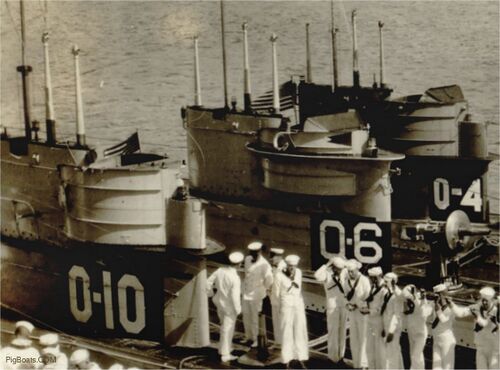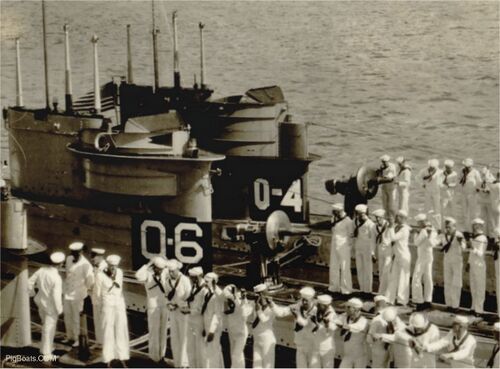O-4: Difference between revisions
Pbcjohnston (talk | contribs) (Created O-4 page) |
Pbcjohnston (talk | contribs) (Added captions) |
||
| (3 intermediate revisions by 2 users not shown) | |||
| Line 1: | Line 1: | ||
[[File:Header Plans.jpg]] | [[File:Header Plans.jpg]] | ||
<div style="text-align: justify;"><span style="color:#00008B"> | [[File:O-4 crew with others.jpg|left|500px]] | ||
<div style="text-align: justify;"><span style="color:#00008B">This is an excellent photo of four O-class submarines approximately 1921. The location is not known for sure, but we suspect it to be Balboa, Panama on the Pacific side of the Canal. O-4 is moored outboard, with [[O-6|'''O-6 (SS-67)''']] inboard, and [[O-10|'''O-10 (SS-71)''']] next to her. There is another boat closest to the camera that can't be identified. There are several other vessels in the background that may be waiting their turn to enter the canal. | |||
All crews are on deck and appear to be, like most young sailors, fidgeting, waiting for whatever is going to happen to happen. The men are in dress whites and trying to keep them clean. It could be a change of command for the Squadron or Division or maybe a general inspection. | |||
The O-4 and O-6 have their 3"/23 caliber deck guns raised, the O-10's gun is still housed and there seems to be a discussion among chiefs and officers standing around it. | |||
<small>Photo in the private collection of Ric Hedman</small> | |||
[[File:Red bar sub new.jpg]] | |||
[[File:O-4 other crews.jpg|left|500px]] | |||
This closeup highlights the detail differences between the conning tower fairwaters of the three boats. All three boats were built at the same yard, but O-6 has a wave break installed around the upper edge of the bridge. This lip of steel was designed to deflect waves down and away from the bridge watchstanders. Without it, a breaking wave would have the tendency to inundate the bridge. O-4 and O-6 also have wind breaks installed on the forward edge of the bridge. These angled guards are intended to push wind up and over the heads of the men on the bridge. | |||
Note also the non-standard and highly varied fonts being used for the boat's names. None of the three are exactly the same font or width. This is very unusual for a Navy that otherwise prides itself on uniformity. | |||
All three boats have both periscopes raised, although it appears that they may not be fully raised. O-10 has her radio mast up (behind the periscopes). It was raised using a chain and sprocket system driven by electric motors. | |||
<small>Photo in the private collection of Ric Hedman</small> | |||
[[File:Red bar sub new.jpg]] | |||
[[File:O-4 crew with others upclose.jpg|left|500px]] | |||
A closeup showing details of the raised 3"/23 caliber guns on the O-6 and O-4. The circular gun shields doubled as the watertight top of the tub that the guns retracted into. Only the barrel and the top of the recoil mechanism remained exposed. The base of the gun mount contained clips for holding several (4 to 6) ready use rounds. Once these were fired more ammunition would be brought up from below. The gun was lightweight and easy to use. When retracted it provided little resistance and drag when the boat was under water. However, the gun had a low muzzle velocity and the rounds lacked hitting power. It did not have an effective gunsight, so it was inaccurate. Even worse, it reportedly had a tendency to retract itself into the tub from the force of being fired, posing a real danger to the crewmen firing the weapon. It was not well liked and was removed from the boats when they were laid up in reserve in the 1930's. | |||
<small>Photo in the private collection of Ric Hedman</small> | <small>Photo in the private collection of Ric Hedman</small> | ||
Latest revision as of 11:27, 5 October 2023

All crews are on deck and appear to be, like most young sailors, fidgeting, waiting for whatever is going to happen to happen. The men are in dress whites and trying to keep them clean. It could be a change of command for the Squadron or Division or maybe a general inspection.
The O-4 and O-6 have their 3"/23 caliber deck guns raised, the O-10's gun is still housed and there seems to be a discussion among chiefs and officers standing around it.
Photo in the private collection of Ric Hedman

This closeup highlights the detail differences between the conning tower fairwaters of the three boats. All three boats were built at the same yard, but O-6 has a wave break installed around the upper edge of the bridge. This lip of steel was designed to deflect waves down and away from the bridge watchstanders. Without it, a breaking wave would have the tendency to inundate the bridge. O-4 and O-6 also have wind breaks installed on the forward edge of the bridge. These angled guards are intended to push wind up and over the heads of the men on the bridge.
Note also the non-standard and highly varied fonts being used for the boat's names. None of the three are exactly the same font or width. This is very unusual for a Navy that otherwise prides itself on uniformity.
All three boats have both periscopes raised, although it appears that they may not be fully raised. O-10 has her radio mast up (behind the periscopes). It was raised using a chain and sprocket system driven by electric motors.
Photo in the private collection of Ric Hedman

A closeup showing details of the raised 3"/23 caliber guns on the O-6 and O-4. The circular gun shields doubled as the watertight top of the tub that the guns retracted into. Only the barrel and the top of the recoil mechanism remained exposed. The base of the gun mount contained clips for holding several (4 to 6) ready use rounds. Once these were fired more ammunition would be brought up from below. The gun was lightweight and easy to use. When retracted it provided little resistance and drag when the boat was under water. However, the gun had a low muzzle velocity and the rounds lacked hitting power. It did not have an effective gunsight, so it was inaccurate. Even worse, it reportedly had a tendency to retract itself into the tub from the force of being fired, posing a real danger to the crewmen firing the weapon. It was not well liked and was removed from the boats when they were laid up in reserve in the 1930's.
Photo in the private collection of Ric Hedman
Page created by:
Ric Hedman & David Johnston
1999 - 2023 - PigBoats.COM©
Mountlake Terrace, WA, Norfolk, VA
webmaster at pigboats dot com
